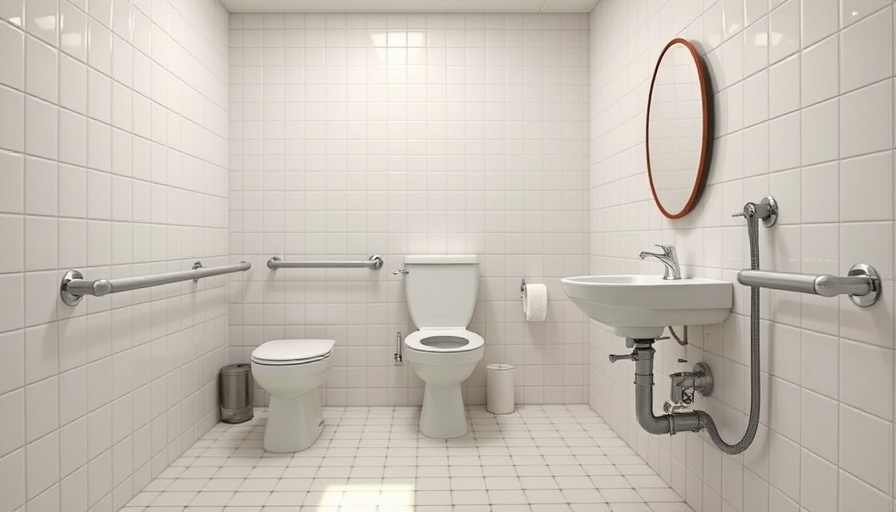
Avoiding ADA Compliance Pitfalls: Essential Bathroom Renovation Tips
Renovating a bathroom while ensuring ADA compliance is essential for creating safe and accessible spaces. Many homeowners, however, overlook crucial aspects of the Americans with Disabilities Act (ADA), leading to costly renovations and unsafe environments. Understanding the common mistakes can help not only in adherence to regulations but also enhance the experience for all users, especially individuals with disabilities.
Understanding ADA Guidelines for Bathroom Renovations
The Americans with Disabilities Act (ADA) aims to eliminate barriers in public spaces, but its guidelines come with practical applications that can significantly improve your home's functionality. Familiarizing yourself with the required specifications, such as toilet heights and grab bar placements, is vital before undertaking any bathroom renovation project. Regulations establish necessary measurements, ensuring that fixtures are appropriately installed to enhance mobility and access.
The Financial Consequences of Non-Compliance
Ignoring ADA guidelines may lead to serious financial repercussions. Homeowners may have to redraft their renovation plans, expend extra funds, or even halt the renovation process altogether if compliance issues arise. For example, ADA violations can require a complete bathroom redesign, causing delays and driving up costs. Proactively understanding the requirements can prevent these setbacks while converting your bathroom into a welcoming, compliant oasis.
Common Mistakes in Designing Accessible Bathrooms
Designing an accessible bathroom requires attention to detail. One persistent mistake is the insufficient turning space that wheelchair users need; a minimum turning radius of 60 inches is required. Additionally, the placement of grab bars is frequently mishandled. They must be installed securely at heights between 33 to 36 inches to ensure they can support users adequately. Avoiding these pitfalls is essential for fostering an environment of safety and independence.
Thoughtful Fixture Selection and Layout
Choosing the right fixtures is another area where many homeowners miss crucial ADA compliance marks. For instance, while pedestal sinks may look visually appealing, they often fail to provide necessary knee clearance for individuals using wheelchairs. Instead, consider wall-mounted sinks that combine aesthetics with function. Lever handles or touchless faucets can also significantly ease use for those with limited dexterity.
Real-Life Success Stories in ADA Compliance
Many homeowners have successfully navigated the complexities of ADA compliance and design through thoughtful planning and execution. For instance, one remodel featured a beautifully designed, compliant bathroom that seamlessly merged style with accessibility. The homeowners prioritize both appearance and function, proving that significant compliance can enhance satisfaction and usability for all residents and visitors.
Counterarguments: Overthinking Compliance?
While many advocate for strict adherence to ADA regulations, some argue that customizing spaces for the unique needs of one’s household is enough. However, this perspective can overlook the importance of universal design principles that benefit everyone, regardless of physical ability. Striving for compliance ensures a space is inclusive and usable by all, catering to unexpected circumstances, and establishing a legacy of accessibility.
Actionable Steps Towards ADA Compliance
To ensure your bathroom renovation meets ADA standards, start by conducting thorough research on the guidelines. Consult with professionals experienced in ADA compliance to assess your needs accurately. Incorporate user feedback when making design decisions, and don’t hesitate to make adjustments during the renovation process if necessary. Remember, prioritizing inclusivity contributes not only to compliance but to the quality of life for all bathroom users.
Creating an accessible, aesthetically pleasing bathroom doesn’t have to be challenging. By understanding the common pitfalls and addressing them head-on, you can enhance safety, independence, and style. Become educated on ADA guidelines and consider them an integral part of your renovation journey, rather than a barrier. With the right approach, your next bathroom renovation can respect the necessary regulations while providing a sanctuary for you and your loved ones.
If you're planning a bathroom renovation, don’t hesitate to reach out to experienced professionals who specialize in ADA compliance. Their expertise can guide your project effectively while avoiding costly mistakes. Commit to making your space accessible and transforming it into a haven for everyone.
 Add Row
Add Row  Add
Add 




Write A Comment